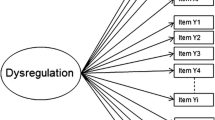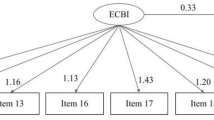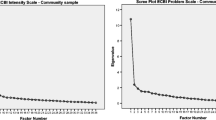Abstract
Disruptive behavior in childhood is common. It spans from normative child misbehaviors to clinically-significant and impairing problems. While there are many rating scales evaluating such behaviors, historically, measurement has emphasized counting the number of symptoms present rather than assessing the normal-abnormal spectrum of behavioral expression. This study uses data from 644 early school age children aggregated from two data sources to statistically link a commonly used symptom count measure, the Child Behavior Checklist (CBCL), to a more developmentally-sensitive measure, the Multidimensional Assessment Profile of Disruptive Behavior (MAP-DB). Two links between conceptually similar scales on each measure were developed: CBCL Conduct Problems and MAP-DB Aggression; and CBCL Oppositional Defiant Problems and MAP-DB Temper Loss. We compared two innovative methods—Item Response Theory (IRT) and Deming regression—to determine the optimal linking relationship. Results suggest IRT methods were superior in reducing linking error compared to Deming regression. While Deming regression accurately modeled the mean scores (thus minimizing linking bias), this method could not adequately address the floor effect for scores on the CBCL. For practical purposes, this study provides a crosswalk of score conversions between the CBCL and MAP-DB, such that data aggregation and group comparisons can be made across the two measures; this enables longitudinal analyses with historically-collected CBCL data to transition to the more innovative dimensional scales of the MAP-DB without undo loss of extant data. This study furthers efforts to shift from historical symptom counts to more developmentally-sensitive measurement across the disruptive behaviors spectrum.



Similar content being viewed by others
References
Achenbach, T. M., Conners, C. K., Quay, H. C., Verhulst, F. C., & Howell, C. T. (1989). Replication of empirically derived syndromes as a basis for taxonomy of child/adolescent psychopathology. Journal of Abnormal Child Psychology, 17, 299–323.
Achenbach, T. M., & Ruffle, T. M. (2000). The child behavior checklist and related forms for assessing behavioral/emotional problems and competencies. Pediatrics in Review, 21, 265–271.
American Psychiatric Association. (2013). Diagnostic and statistical manual of mental disorders (DSM-5®) (5th ed.). Washington, DC.
Biedzio, D., & Wakschlag, L. S. (2018). Developmental emergence of disruptive behaviors beginning in infancy: delineating normal:abnormal boundaries to enhance early identification. In press.
Bland, J. M., & Altman, D. (1986). Statistical methods for assessing agreement between two methods of clinical measurement. The Lancet, 327, 307–310.
Briggs‐Gowan, M. J., Nichols, S. R., Voss, J., Zobel, E., Carter, A. S., McCarthy, K. J., & Wakschlag, L. S. (2014). Punishment insensitivity and impaired reinforcement learning in preschoolers. Journal of Child Psychology and Psychiatry, 55, 154–161.
Bufferd, S., Dyson, M., Hernandez, I., & Wakschlag, L. (2016). Explicating the “developmental” in preschool psychopathology. In D. Cicchetti (Ed.), Handbook of Developmental Psychopathology. 3rd ed. (pp. 152–186). New Jersey: Wiley.
Cai, L. (2015). Lord–Wingersky algorithm version 2.0 for hierarchical item factor models with applications in test scoring, scale alignment, and model fit testing. Psychometrika, 80, 535–559.
Carstensen, B. (2010). Comparing methods of measurement: extending the LoA by regression. Statistics in Medicine, 29, 401–410.
Carter, A. S., Gray, S. A., Baillargeon, R. H., & Wakschlag, L. S. (2013). A multidimensional approach to disruptive behaviors: informing life span research from an early childhood perspective. In P. Tolan & B. Leventhal (Eds.), Disruptive Behavior Disorders. Advances in Development and Psychopathology: Brain Research Foundation Symposium Series. (Vol. 1, pp. 103–135). New York: Springer.
Casey, B., Oliveri, M. E., & Insel, T. (2014). A neurodevelopmental perspective on the research domain criteria (RDoC) framework. Biological Psychiatry, 76, 350–353.
Choi, S. W., Schalet, B., Cook, K. F., & Cella, D. (2014). Establishing a common metric for depressive symptoms: linking the BDI-II, CES-D, and PHQ-9 to PROMIS depression. Psychological Assessment, 26, 513.
Cuthbert, B. N., & Insel, T. R. (2013). Toward the future of psychiatric diagnosis: the seven pillars of RDoC. BMC Medicine, 11, 126.
Dorans, N. J. (2007). Linking scores from multiple health outcome instruments. Quality of Life Research, 16, 85–94.
Franklin, J. C., Jamieson, J. P., Glenn, C. R., & Nock, M. K. (2015). How developmental psychopathology theory and research can inform the research domain criteria (RDoC) project. Journal of Clinical Child & Adolescent Psychology, 44, 280–290.
Garvey, M., Avenevoli, S., & Anderson, K. (2016). The national institute of mental health research domain criteria and clinical research in child and adolescent psychiatry. Journal of the American Academy of Child & Adolescent Psychiatry, 55, 93–98.
Grabell, A. S., Li, Y., Barker, J. W., Wakschlag, L. S., Huppert, T. J., & Perlman, S. B. (2018). Evidence of non-linear associations between frustration-related prefrontal cortex activation and the normal: abnormal spectrum of irritability in young children. Journal of Abnormal Child Psychology, 46, 137–147.
Karim, H. T., & Perlman, S. B. (2017). Neurodevelopmental maturation as a function of irritable temperament. Human Brain Mapping, 38, 5307–5321.
Kolen, M. J., & Brennan, R. L. (2014). Test equating, scaling, and linking: methods and practices. (3rd ed). New York: Springer.
Krueger, R. F., & Piasecki, T. M. (2002). Toward a dimensional and psychometrically-informed approach to conceptualizing psychopathology. Behaviour Research and Therapy, 40, 485–499.
Mittal, V. A., & Wakschlag, L. S. (2017). Research domain criteria (RDoC) grows up: Strengthening neurodevelopment investigation within the RDoC framework. Journal of Affective Disorders, 216, 30–35.
Perlman, S. B., Jones, B. M., Wakschlag, L. S., Axelson, D., Birmaher, B., & Phillips, M. L. (2015). Neural substrates of child irritability in typically developing and psychiatric populations. Developmental Cognitive Neuroscience, 14, 71–80.
Perlman, S. B., Luna, B., Hein, T. C., & Huppert, T. J. (2014). fNIRS evidence of prefrontal regulation of frustration in early childhood. Neuroimage, 85, 326–334.
Reise, S. P., Cook, K. F., & Moore, T. M. (2015). Evaluating the impact of multidimensionality on unidimensional item response theory model parameters. In S. P. Reise & D. A. Revicki (Eds.), Handbook of Item Response Theory Modeling. (pp. 13–40). New York: Routledge.
Reise, S. P., & Waller, N. G. (2009). Item response theory and clinical measurement. Annual Review of Clinical Psychology, 5, 27–48.
Stringaris, A., Goodman, R., Ferdinando, S., Razdan, V., Muhrer, E., Leibenluft, E., & Brotman, M. A. (2012). The affective reactivity index: a concise irritability scale for clinical and research settings. Journal of Child Psychology and Psychiatry, 53, 1109–1117.
Wakschlag, L. S., Briggs-Gowan, M. J., Choi, S. W., Nichols, S. R., Kestler, J., Burns, J. L., & Henry, D. (2014). Advancing a multidimensional, developmental spectrum approach to preschool disruptive behavior. Journal of the American Academy of Child & Adolescent Psychiatry, 53, 82–96.
Wakschlag, L. S., Estabrook, R., Petitclerc, A., Henry, D., Burns, J. L., Perlman, S. B., & Briggs-Gowan, M. L. (2015). Clinical implications of a dimensional approach: the normal: abnormal spectrum of early irritability. Journal of the American Academy of Child & Adolescent Psychiatry, 54, 626–634.
Wakschlag, L. S., Henry, D. B., Tolan, P. H., Carter, A. S., Burns, J. L., & Briggs-Gowan, M. J. (2012). Putting theory to the test: modeling a multidimensional, developmentally-based approach to preschool disruptive behavior. Journal of the American Academy of Child & Adolescent Psychiatry, 51, 593–604.
Wakschlag, L. S., Perlman, S. B., Blair, R. J., Leibenluft, E., Briggs-Gowan, M. J., & Pine, D. S. (2018). The neurodevelopmental basis of early childhood disruptive behavior: irritable and callous phenotypes as exemplars. American Journal of Psychiatry, 175, 114–130.
Wakschlag, L. S., Tolan, P. H., & Leventhal, B. L. (2010). Research review:‘Ain’t misbehavin’: towards a developmentally‐specified nosology for preschool disruptive behavior. Journal of Child Psychology and Psychiatry, 51, 3–22.
White, S. F., Briggs-Gowan, M. J., Voss, J. L., Petitclerc, A., McCarthy, K., R. Blair, R. J., & Wakschlag, L. S. (2016). Can the fear recognition deficits associated with callous-unemotional traits be identified in early childhood? Journal of Clinical and Experimental Neuropsychology, 38, 672–684.
Funding
Research reported in this publication as supported by the National Institute of Mental Health under award number 1R01MH082830 and 2U01MH082830 (PI: Wakschlag); R01MH107540 and K01MH094467 (PI: Perlman); and by the National Institutes of Health Office of the Director under award number 1U24OD023319 (MPIs: Gershon, Cella).
Author information
Authors and Affiliations
Corresponding author
Ethics declarations
Conflict of Interest
The authors declare that they have no conflict of interest.
Informed Consent
Informed consent was obtained from all individual participants included in the original studies which contributed de-identified data to this re-analysis.
Statement on Human Rights
This study involved re-analysis of de-identified data and thus was not human subjects research. For this type of study, formal consent is not required. However, all original studies contributing data to this re-analysis were conducted in accordance with the ethical standards of the institutional and/or national research committee and with the 1964 Helsinki declaration and its later amendments or comparable ethical standards.
Statement on the Welfare of Animals
This article does not contain any studies with animals performed by any of the authors.
Rights and permissions
About this article
Cite this article
Kaat, A.J., Blackwell, C.K., Estabrook, R. et al. Linking the Child Behavior Checklist (CBCL) with the Multidimensional Assessment Profile of Disruptive Behavior (MAP-DB): Advancing a Dimensional Spectrum Approach to Disruptive Behavior. J Child Fam Stud 28, 343–353 (2019). https://doi.org/10.1007/s10826-018-1272-4
Published:
Issue Date:
DOI: https://doi.org/10.1007/s10826-018-1272-4




